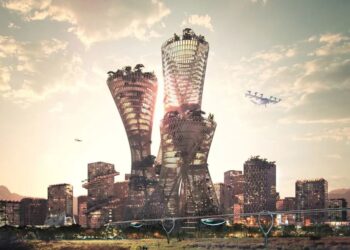Infrastructure development drives a country’s economy as it helps set up new businesses and eases commute and logistics. India is the fastest-growing economy in the world and aspires to be a $5 trillion economy by 2028 and infrastructure is a crucial pillar to ensure good governance but unfortunately, it was one of the most backward sectors until 2014. Infrastructure creation in India had suffered for decades as the developmental projects were very few and most of them were either stalled or passed on paper but never executed due to time-taking approval process and multiplicity of regulatory compliance.
As an outcome, the roads of India were recognized because of the potholes rather than expressways. Not just this, there was a lack of coordination between different departments and they were planning and designing the projects in silos because of which once a road was constructed, other agencies would dig up that road for laying of underground cables, gas pipelines, and then again reconstruct the road leading to wasteful expenditure and inconvenience to the commuters. There was an urgent need for road infrastructure, railways upgradation, and air connectivity that is both cost-effective and sustainable while adhering to strict timelines and uncompromising standards of quality.
Under Modi government, there have been various initiatives launched to develop better infrastructure across all sectors such as national highways, trains and new airports among others. One of the key initiative was launch of PM Gati Shakti – National Master Plan to improve last mile connectivity and multi-modal connectivity across the country. This has been the most extensive plan for infrastructure development in the history of independent India where government is investing nearly Rs 100 lakh crore to bring about systemic and effective reforms in the sector.
Launched in 2021, this plan brought 16 ministries including Railways and Roadways together for integrated planning and coordinated implementation of infrastructure connectivity projects. It is also leveraging technology by using spatial planning tools with ISRO imagery developed by BiSAG-N (Bhaskaracharya National Institute for Space Applications and Geoinformatics).
Roads and Highway Development
Gati Shakti has already shown a significant headway by facilitating the last mile connectivity of infrastructure and reducing the travel time for people. As an outcome, India has added over 53 thousand 868 kilometres to its National Highways network between 2014-23.
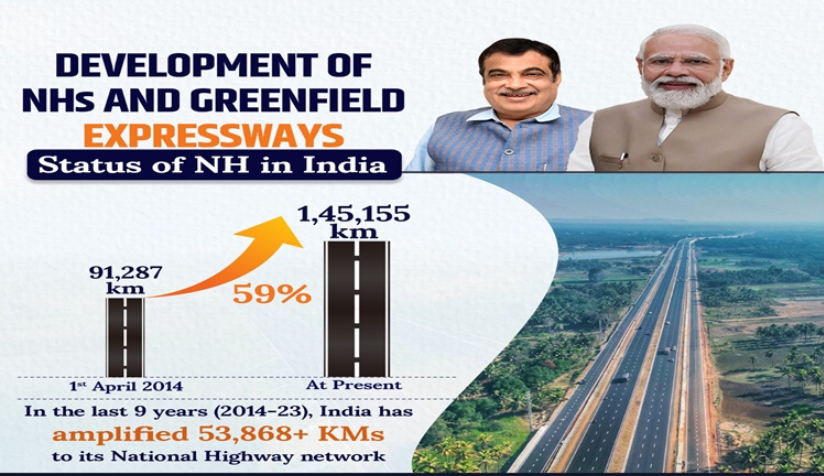
This has helped to improve the global competitiveness of local products by cutting down the logistics costs and improving the supply chains, and also ensuring proper linkages for local industry & consumers. There is a 500% increase in road, transport and highway allocation budget since 2014 and 3.26 lakh km of rural road has been built since 2014 resulting in increase of rural road connectivity to 99%.
India already has the second largest highway road network in the world after the US and his government’s mandate is to further improve the road infrastructure of the country.

The government has also successfully monetized the roads by making roads into a profitable business. As per data from government, Toll income from highways is presently Rs 40,000 crore and by 2024 it will be Rs 1.4 lakh crore.
Furthermore, PM-eBus Sewa scheme has been approved in August 2023. This initiative aims to enhance city bus services by introducing 10,000 electric buses (e-buses), leading to an improved urban public transportation system and the creation of numerous job opportunities. The initiative will cover 169 cities with populations exceeding 300,000, including capital cities of Union Territories, North Eastern Region, and hill states.
The program will support bus operations for a decade and will primarily target areas without organized bus services. This strategic approach is anticipated to generate 45,000 to 55,000 direct jobs. The scheme will not only improve public transportation but also lead to infrastructure upgrades in 181 cities, aligning with the Green Urban Mobility initiatives. The scheme underscores the government’s dedication to implementing eco-friendly solutions to address various challenges.
Additionally, forward-looking projects such as the National Common Mobility Card, the Intelligent Transit Management System, and Multimodal Interchange facilities are also in the pipeline for development.
Ropeway Development
Building an efficient transport system in the hilly areas is quite difficult due to technical obstacles. To handle this challenges and provide a convenient and safe form of transportation, national ropeway development program – Parvatmala has been launched for hilly areas such as Himachal Pradesh, Uttarakhand, Jammu-Kashmir and the Northeast. This will not only provide convenience and enhance tourism to these areas but will also strengthen the border areas which is essential from a security aspect. Furthermore, ropeways will enable mobility to people living in the difficult areas and help them become part of the
mainstream. The government is planning to develop more than 250 projects with a ropeway length of around 1200 km in next 5 years.
Border Infrastructure Development
The border infrastructure development has also gained prominence in this decade and strategically important all-weather Atal Tunnel, at Rohtang in Himachal Pradesh was opened in 2020. Built by Border Roads Organization, this is the longest highway tunnel in the world which reduces the distance between Manali and Leh by 46 km and the travel time by four to five hours. This has been a saviour for armed forces for quick troop movement to Ladakh amid heightened tensions between India and China.
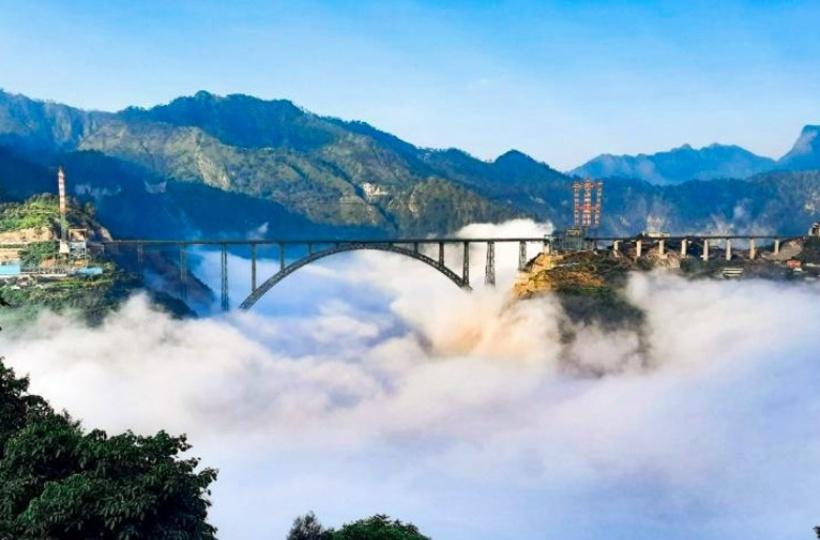
Besides this, world’s highest railways bridge ‘Chenab Bridge’ that provided direct connectivity to Kashmir was inaugurated in 2022. This bridge is 359m above the river bed level thus 35 meters higher than the iconic Eiffel Tower in Paris making it the highest railway bridge. Additionally, to step up defence in the Ladakh sector, Shinkun La Tunnel has been approved for construction and will be operational by December 2025. This new tunnel will allow all-weather connectivity to Ladakh from Himachal Pradesh via Manali-Darcha axis and allow faster deployment of Indian troops to tackle any flare up in Kargil-Siachen sector with Pakistan or with PLA in East Ladakh.
Indian Railways Infrastructure
The Indian Railways has a massive network that handles 800 crore passengers every year but was struggling with safety, cleanliness and modernisation issues for a long time. In the last decade, it has undergone major transformation and railways has seen a marked improvement in benchmarks such as punctuality, cleanliness, offering good services to passengers and safety along with upgrading their technology.
Echoing the spirit of ‘India First, Always First’, the railways ministry announced the manufacture of 400 world-class semi-high-speed Vande Bharat trains in India that can run at a maximum speed of 180 Km/h and contain world-class shuttle like facilities such as GPS-based passenger information system, bio-vacuum toilets, and rotational seats that can be aligned in the direction of travel. Out of these 400, 34 Vande Bharat trains are already operational as of September, 2023. These trains have become synonymous with development, modernity, self-reliance and stability. In addition to this, to save up commuting time for passengers,
8 rail corridors have been approved for high-speed Bullet Trains that will run at a speed of 350 kms per hour. The first Bullet Train will be operational in 2026 between Ahmedabad and Mumbai Also, Bharat Gaurav Trains which are theme-based tourist circuit trains that showcase India’s rich cultural heritage and magnificent historical places are being planned to be launched in next 5 years. These trains have been set across diverse circuits and the train packages include your stay as well as off-board excursions, meals and guided tours. One of the most popular Bharat Gaurav Train is “North East Discovery: Beyond Guwahati” that commences a 15-day tour to cover 5 North East states of Assam, Tripura, Nagaland and Meghalaya.
With respect to safety measures, India has designed an indigenously designed anti-collision system ‘Kavach’ that would enable even two high-speed trains coming towards each other to avoid hitting each other. Due to these measures, Train accidents which were a common phenomenon earlier have also become rare with 34 straight months without any rail passenger fatalities. Furthermore, 6565 km of rail track has been electrified as a part of electrification with investment of INR 6657 crore, propelling Railways towards achieving the goal of 100 per cent electrification. As per data from World of Statistics, India is ranked second in the list of world countries with respect to Railways Electrification.
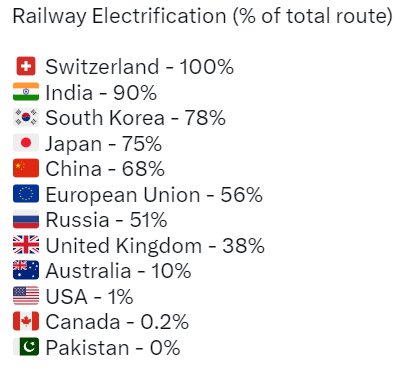
Also, the Indian Railways Redevelopment plan has been announced in 2022 within which 400 railway stations across India will be redeveloped at Rs 1 lakh crore through Public Private Partnership (PPP) mode. The objective of this program is to improve passenger amenities by leveraging real estate available with railways to fund the development. As an outcome of these initiatives, in the financial year 2022-2023, the internal revenue of railways has seen an uprise of 19% and is estimated to be Rs 2,40,000 crore.
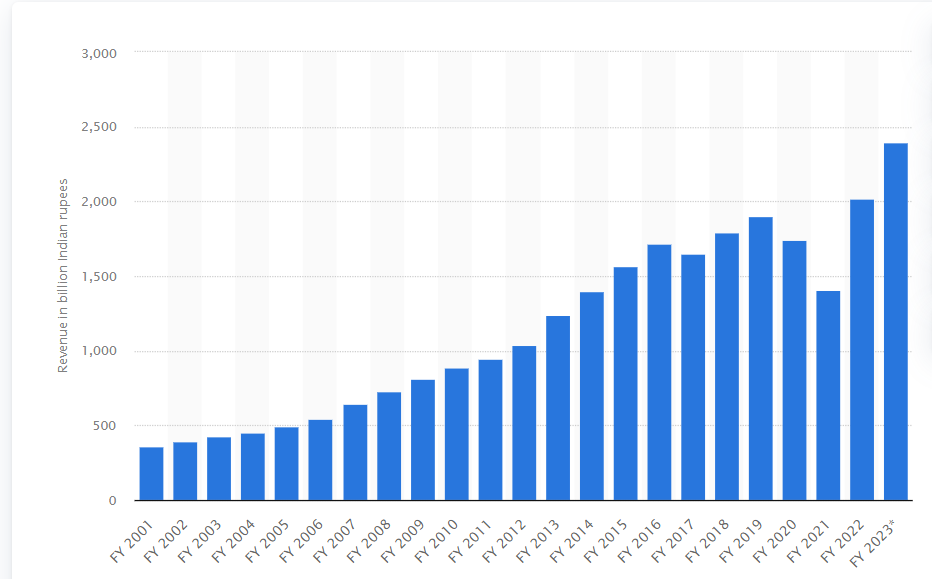
Also, Railways has achieved record Freight loading of 1512MT in FY 2022-2023. In the last decade, Indian railways have undergone a changeover and the government has successfully developed Next Generation Infrastructure in Railways which has improved Ease of Living as well as Ease of Doing Business.
Aviation Infrastructure
The aviation sector provides better connectivity that brings people closer and boosts national progress. To facilitate growth of Aviation industry, the Ministry of Civil Aviation launched the Regional Connectivity Scheme – UDAN in 2016 to enhance regional air connectivity across the country from unserved and underserved airports in the country and making air travel affordable to the masses. In a mission mode, 7 new airports were built in North East in the last 8 years which improved connectivity and increased the number of domestic as well as international tourists.
As per provisional data from Ministry of Tourism, Government of India, 118.45 lakh domestic and 1.04 lakh foreign tourists visited the North Eastern States during the year 2022. In addition to this, since 2014, 74 new airports have been built in India and plan is to develop and operationalize 220 airports in next 5 years. Further to this, central government has allocated 98000 crore rupees for the development of existing airports and construction of 21 new Greenfield airports out of which 11 have been operationalized.
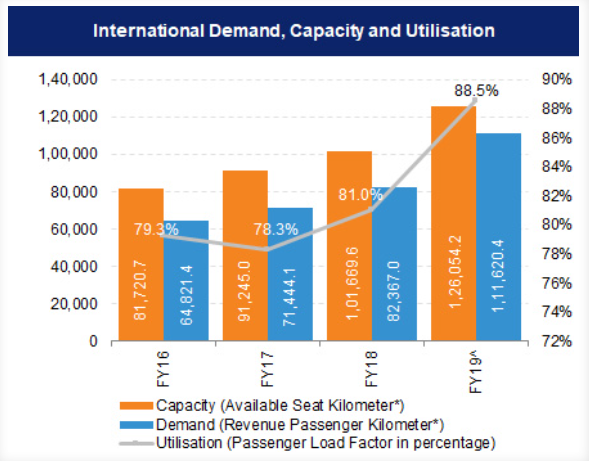
As the world becomes more connected, the international aviation industry is taking off – with surging demand driving unprecedented capacity and utilization. The demand of India is expected to overtake China and the United States as the world’s third-largest air passenger market in the next ten years, by 2030, according to the International Air Transport Association (IATA). Further, the rising demand in the sector has pushed the number of airplanes operating in the sector and the number of airplanes is expected to reach 1,100 planes by 2027.
Waterways Infrastructure
The infrastructure development that was earlier limited to road, train and air has been enhanced with the addition of waterways. India has great potential in waterways transport since the country has more than 125 rivers and it can become a cheap as well as faster mode of travel especially in the eastern part of India. As on 2014, there were only 5 national waterways which has increased to 111 in 2023.
Out of these 111 waterways, 23 river systems have feasibility for navigation and government is planning to develop these 23 river systems by 2030 for cargo and passenger vessel movement, aiming for greater use of inland waterways as a cheaper mode of transport. These inland waterways will be very useful for transporting Bulk cargo like coal, fly-ash and iron ore which will not only be cost-effective but also environment friendly. Another project launched by the government’s is ‘Arth Ganga’ model wherein small jetties would be set up along the Ganga to energise economic activity along river banks in Uttar Pradesh, Bihar, Jharkhand and West Bengal. This will bring down the logistics cost for farmers in the movement of local produce.
Moving on from trade to tourism, PM Modi launched world’s longest river cruise, the ‘MV Ganga Vilas’ that travels 3,200 km over 27 river systems in five states in India and Bangladesh in 51 days in 2022. This project was developed under the public–private partnership (PPP) model and has given a big boost to the water tourism sector. Besides this, India’s first water metro that has connected 10 islands around Kochi, Kerala through battery-operated electric hybrid boats was launched in 2023. This has been termed as game-changing project as it has provided a new means of transport that is cost-effective for cities that are surrounded by water systems.
There has been a phenomenal growth in the infrastructure sector leading to improvement in connectivity in the country across various sectors of road, train, air and waterways. This has put India on the fast track to growth by reducing the cost of delivered goods, facilitate the physical mobility of people and products, remove productivity constraints, and increase competitiveness. The government has provided the much-needed impetus to infrastructure development in the last decade and it is reasonable to conclude that India has a bright future ahead of it
References
https://www.ibef.org/industry/infrastructure-sector-india
https://www.india.gov.in/spotlight/pm-gati-shakti-national-master-plan-multi-modal-connectivity
https://www.statista.com/statistics/623450/railway-revenue-india/


